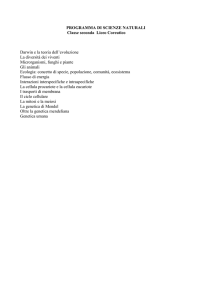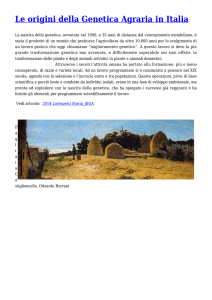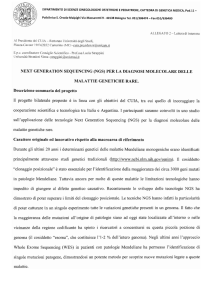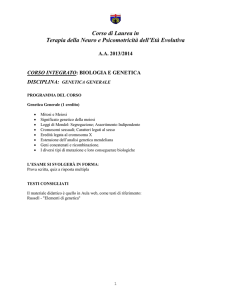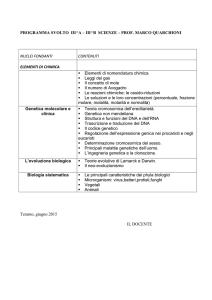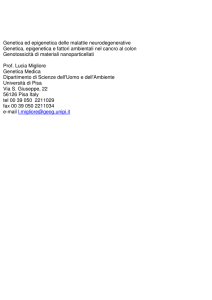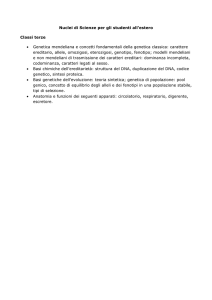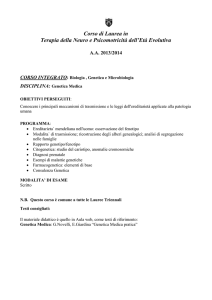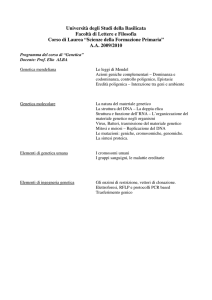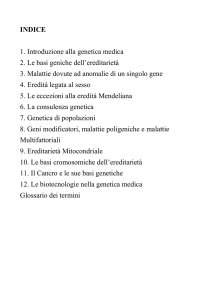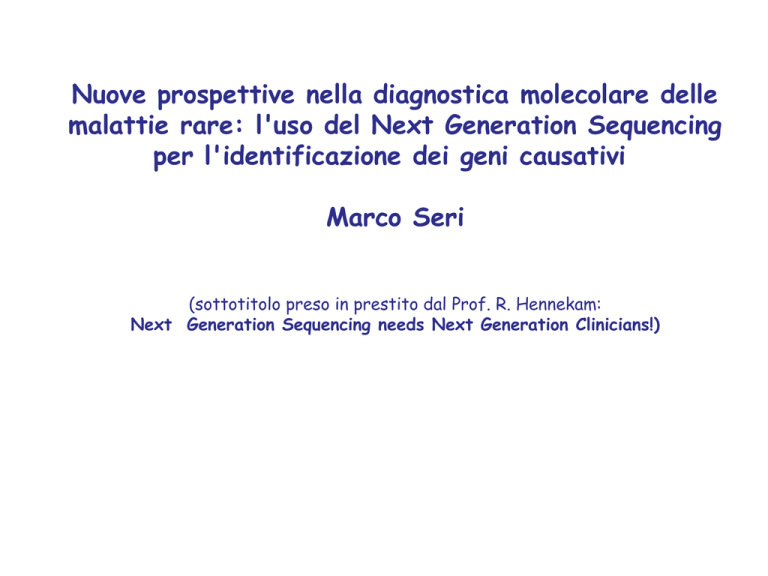
Nuove prospettive nella diagnostica molecolare delle
malattie rare: l'uso del Next Generation Sequencing
per l'identificazione dei geni causativi
Marco Seri
(sottotitolo preso in prestito dal Prof. R. Hennekam:
Next Generation Sequencing needs Next Generation Clinicians!)
Genetica Clinica
• L’introduzione delle tecnologie avanzate
stanno cambiando l’approccio allo studio
delle malattie genetiche mendeliane e
conseguentemente anche l’atteggiamento
del genetista clinico.
“Clinici di nuova generazione”
• La Genetica Clinica sta diventando il “nucleo”
di questo cambiamento, mettendo assieme le
innovazioni tecnologiche e la ricerca alle
competenze cliniche
• Proprio per questo il compito del Genetista
Clinico non è mai stato così complesso come
oggi: non è cosa semplice trasferire a livello
clinico l’enorme quantità di informazioni
provenienti dall’attività di ricerca.
MENDELIAN INHERITANCE IN MAN ( MIM )
1^ edizione 1966: 1500 voci – oggi: >20000
Dal 1998: solo in forma elettronica
OMIM: On-lineMIM
http://www.ncbi.nlm.nih.gov/entrez/
Genetic Medicine Paradigm
DNA
RNA
Modified
Proteins
Proteins
Biological
Function
Y
Y
Transcription
25.000 Genes
Translation
Post-Translation
Modification
> 1,000,000 Proteins
Information: Critical to Understanding Disease Mechanisms
Geni e malattie: una nuova dimensione
sano
Malattia
monofattoriale
normale
Variazione 1:
Mutazione
Variazione 2: polimorfismo
Sano, ma
con una
proteina
che funziona
di più o di
meno:
suscettibilità
NGS DNA SEQUENCING EXPERIMENTAL DESIGNS
TARGETED
REGION
TARGETED
GENES
WHOLE EXOME
WHOLE GENOME
X
EXOME
Next Generation Sequencing e sue possibili
applicazioni in campo clinico
NGS per Diagnostica
Eterogeneità Genetica
Il concetto classico di Eterogeneità genetica implica
il fatto che la stessa condizione può essere causata
da mutazioni in geni differenti e questo sta
divenendo un problema consistente in Genetica
Medica
Per alcune malattie il grado di eterogeneità
genetica è tale che ci sono più di 100 geni che
possono causare la stessa malattia
La Retinite Pigmentosa (RP) è un gruppo eterogeneo di
malattie ereditarie caratterizzato dalla progressiva perdita
della vista, cecità notturna e depositi di pigmento nella retina.
NGS per Ricerca
Geography of exome sequencing
Schinzel-Giedion
N a tG e n e t A pr 1 0
Miller syndrome
Na t G e ne t N ov 0 9
HPMR
N a tG e n e t A u g 1 0
Kabuki syndrome
N a tG e n e t A ug 1 0
DFNB82
A m J H u m G e n e t J un 1 0
Perrault syndrome
A m J Hu m G e n e t J ul 1 0
Brain Malformation
N a tu re A u g 1 0
UNITED WE STAND
DE NOVO
COMPOUND HETEROZYGOSITY
HOMOZYGOSITY
Sindromi malformative
Malattie Mendeliane non
Sindromiche
FA2H causes SPG35 and leukodystrophy
Two affected sibs from a consanguineous family
carry a c.270+3A>T mutation in the FA2H gene
exon 1 exon 2
L
R
G
E
Q
Q
G
S
M
E
N
E
P
V
L
R
G
E
Q
Q
V
Q
P
G
R
G
P
P
Single Nucleotide Variants SNVs
Sib1
Sib 2
Validated
20967
22651
Transition to transversion ratio
2.91
2.89
In dbSNP
19727 (94%)
21237 (94%)
Heterozygous in dbSNP
10372
11159
Homozygous in dbSNP
9355
10078
Not in dbSNP
1240 (6%)
1414 (6%)
Heterozygous not in dbSNP
1086
1234
Homozygous not in dbSNP 130
154
180
Candidate variants filtering
Cumulative total calls: 22711
ROHs in common: 28
No 1000 genomes: 8
NS, in UTRs, SS, nonsense: 28
Cumulative no dbSNPs: 1968
2 NS (1 gene) damaging by at least one prediction tool (SNP&GO, Polyphen, SIFT)
1 altering SS by at least one prediction tool (NetGene2, GDB)
+1bp del
A novel FA2H c.270+3A>T splice site mutation in an Italian consanguineous pedigree
Malattie legate al cromosoma X
TARGETED RESEQUENCING OF X CHROMOSOME EXONS
Length (Mb)
~ 150
CCDS entries
1153
RefSeq entries
2036
OMIM loci/genes
716
Agilent SureSelect human X chromosome
probes
7664
Probe/CCDS genomic regions overlap
95%
Probe/RefSeq genomic regions overlap
94%
I
1
2
1
2
1
2
1
2
II
1
1
2
1
2
1
2
A CASE STUDIED WITH BOTH “CLASSICAL”
AND “NEXT GENERATION” APPROACHES
X-linked recurrence of a previously undescribed neurocutaneous phenotype
ndividuals III-2 and III-4:
microcephaly, neurodevelopmental delay, ichthyosis, epilepsy, tetraparesis
and ACC
Male fetus III-3:
ACC callosum and hyperkeratosis of epidermis with desquamation
at the autoptic examination after voluntary abortion
ndividuals I-2, II-2 and II-3: mild ichthyosis limited to the extensor surfaces of
Limbs compatible with a balanced chromosome X inactivation pattern
POSITIONAL CLONING OF A PAK3 VARIANT
.
Magini et al., submitted
NGS-BASED DETECTION OF A PAK3 VARIANT
CHR BAND
GEN
E
hg19
Xp22.31
STS
7268094
.
.
Xp22.12
MAP3K15
.
Xq13.1
STARD8
.
Xq23
PAK3
CHANGE
19443659
67940201
110439126
SANGER
p.L515
P
+
LINKAG
E
?
-
p.P477T
+
-
p.G582fs
-
-
p.K389
N
+
+
NGS per Malattie Complesse
“Personal Geneticist”
DISCOVERY STRATEGIES IN COMMON DISEASES
Patient – Family history of vascular disease
and early sudden death
Challenges…
Poche conoscenze della genetica da parte del
paziente
Nonostante l’interpretazione corretta del genoma del
paziente
Un genoma è interpretato secondo le
conoscenze attuali
Se sono predette per ogni persona circa 100
mutazioni recanti un ipotetico rischio;
Se impieghiamo 3 min per disordine occorrono
circa 5 ore di consulenza diretta con il paziente.
Come acquisire il consenso
informato?
Come trasferire con successo
l’informazione dei risultati?
Come ricontattare il paziente per i
cambiamenti che possono
sopravvenire?
Chi fa tutto ciò?
Chi paga per tutto ciò?
Nuovi problemi per vecchie ricette
Consulenza genetica
asp e t
t a ti v
e
a mi l i a
re
du b b i
sentimenti
e
t
s
e
i
h
c
ri
st o r i a f
Obiettivo:
Processo di
comunicazione
bidirezionale
Non-direttivo
ne
o
i
z
a
e du c d i e r e d o à
t
i
l
i
b
p r o b a i l i ar i t à
fam
rischio individuale
o pz io n i
p r e v en t
i ve
mettere il paziente in condizione
di compiere scelte informate e consapevoli
Genetic Counselling
•discuss the possibility that clinical assessment might uncover high risk of a serious disease,
including some for which there is no treatment
•describe the reproductive implications of heterozygous status for autosomal recessive
diseases such as cystic fibrosis, which might not be predictable from family history
•warn of increases or decreases in genetic risk for common diseases.
•note that most of the sequence information is difficult to interpret, and discuss error rates
and validation processes
•discuss that risk alleles might be discovered that have reproductive or familial importance
rather than personal importance (such as those for breast or ovarian cancer)
•address the possibility of discrimination on the basis of genetics



